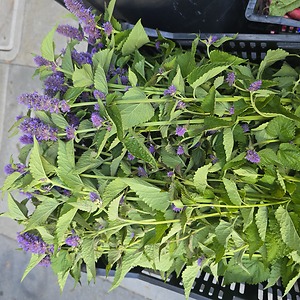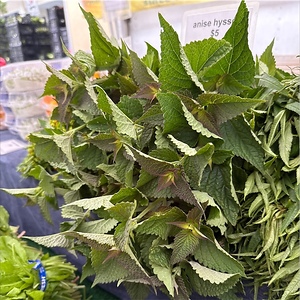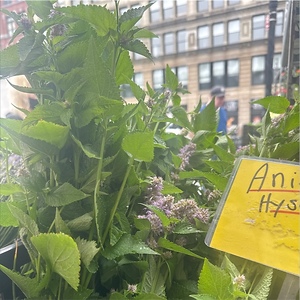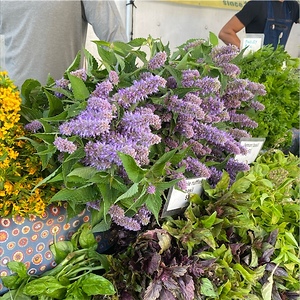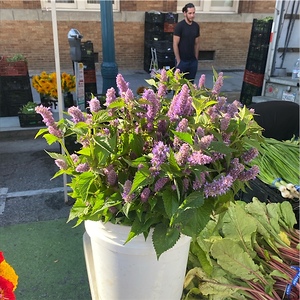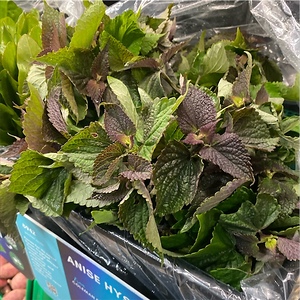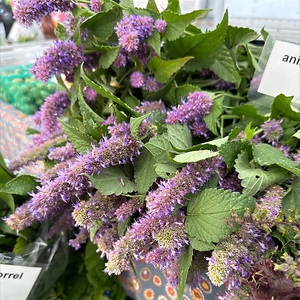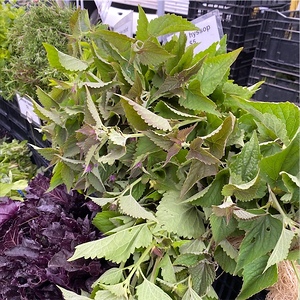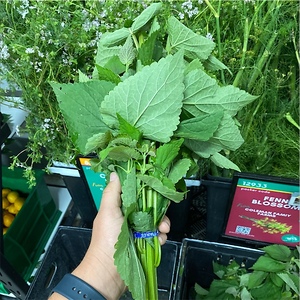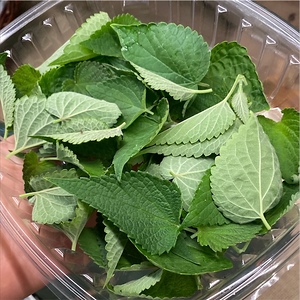

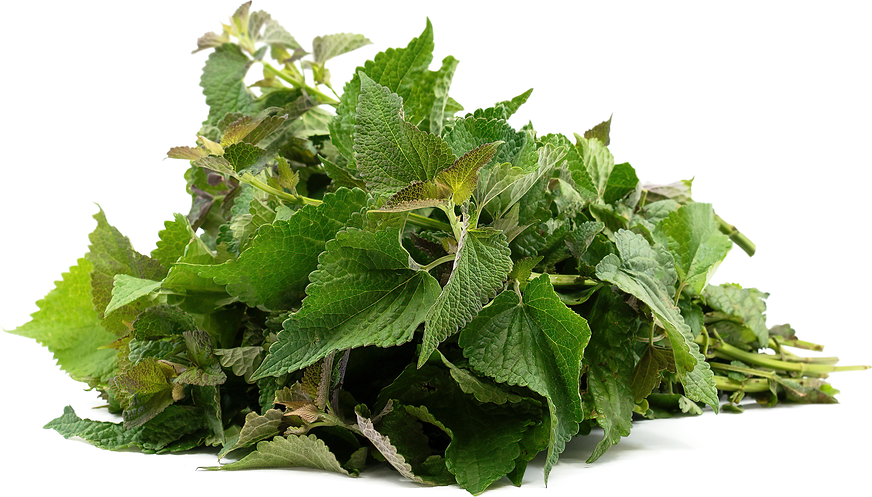
Anise Hyssop
Estimated Inventory, bunch : 18.00
This item was last sold on : 07/30/25
Description/Taste
Anise hyssop is a stiff, upright, leafy herb comprised of characteristic square stalks, flat leaves, and seasonal blooms. The leaves are arranged on opposite sides, averaging five centimeters in diameter and 10 centimeters in length, and have an oval shape, tapering to a distinct point on the non-stem end. The green leaves also bear a textured, veined surface with scalloped, toothed edges and are sometimes tinged with purple. Anise hyssop has a strong aroma, a combination of licorice, root beer, basil, tarragon, and mint, and carries a scent similar to the smell of crushed fennel seeds. The leaves and flowers have a crisp, tender consistency, and unlike other herbs, Anise hyssop is known for its sweet, lemon-like flavor mixed with licorice and mint notes. In addition to the leaves, in the mid to late-summer, ten to fifteen-centimeter spikes of densely packed small, violet, purple, or indigo, two-lipped flowers bloom amid the green leafy stems. The scent and flavor of the flowers are interchangeable with the leaves, and they retain their color and smell even when dried.
Seasons/Availability
Anise hyssop is available fresh in the summer through early fall. Dried leaves and flowers are available year-round.
Current Facts
Anise hyssop, botanically classified as Agastache foeniculum, is a North American perennial herb with a bushy nature that grows up to one meter in height, belonging to the Lamiaceae or mint family. The herbaceous plant has been used medicinally for hundreds of years and is widely naturalized in open plains, prairies, and pastures. Despite its name, Anise hyssop is not related to anise or hyssop. Its common name was derived from the herb's sensory characteristics, including its anise-like fragrance and its blooms, which are similar to those of the true hyssop. Anise hyssop is also known as Blue Giant hyssop, Fragrant Giant hyssop, and Licorice mint, and there are multiple cultivars known among growers that have been bred from the wild plants for home garden cultivation. In 2019, Anise hyssop was awarded Herb of the Year by the International Herb Association. The annual award highlights herbs that are recognized for ornamental, culinary, or medicinal attributes, and Anise hyssop is considered to be outstanding in all three categories. Home gardeners favor anise hyssop for its sweet flavor, fragrant flowers that attract beneficial pollinators, and medicinal properties to soothe colds, coughs, and upset stomach.
Nutritional Value
Anise hyssop contains rich essential oils comprised of methyl eugenol, a natural compound providing antiviral, antibacterial, and anti-inflammatory properties. The essential oils also contain limonene, a compound found to neutralize stomach acid and promote a healthy digestive tract, and methyl chavicol, a compound used to flavor liquors and beverages like root beer.
Applications
Anise hyssop has a fragrant aroma and sweet flavor well-suited for fresh, cooked, and dried applications. The leaves and flowers are edible, often steeped into hot water to make an herbal tea, or they can be blended into smoothies, cocktails, and warm drinks such as hot chocolate. The leaves can also be used as a substitute for French tarragon or mint, or they can be mixed into pasta, tossed into green salads, floated on soups, or stirred into fruit bowls for added flavor. Anise hyssop flowers can be utilized as an edible garnish, infused into vinegar and honey, or sprinkled on top of salads. Beyond fresh preparations, Anise hyssop flowers and leaves can be cooked into jellies, jams, and syrups, simmered into cream-based liquids to make custards and panna cotta, or they can be used to flavor cookies, ice cream, muffins, bread, and other baked goods. Anise hyssop pairs well with citrus, berries, peaches, watermelon, pineapple, apricots, honey, mint, vanilla, and heavy cream. Fresh Anise hyssop should be used immediately for the best quality and flavor and will keep up to one week when stored in a sealed plastic bag in the refrigerator. The leaves and flowers can also be hung upside down and dried for extended use.
Ethnic/Cultural Info
Anise hyssop was used by indigenous tribes of North America for centuries as a medicinal ingredient to soothe symptoms associated with the common cold and act as a digestive aid. The Cree people of Saskatchewan steeped Anise hyssop leaves in hot water to make a comforting tea to reduce congestion, as did the native tribes of Montana, who also used the plant as a flavoring agent. Anise hyssop was also valued for its anti-inflammatory properties, used to reduce irritation on the skin from rashes and burns, and its uplifting scent was believed to calm the senses. On the Great Plains, the Cheyenne used Anise hyssop leaves to treat coughs and colds, and the flowers were made into a tea to help return hope to a saddened heart. Leaves were also used in a steam bath to induce sweating and to treat fevers.
Geography/History
Anise hyssop is native to the prairies and plains of the United States and Canada, specifically a region that spans from Wisconsin to Colorado, up to Ontario, and to the west coast of British Columbia and has been growing wild since ancient times. The herbaceous plant has also naturalized in temperate forests, fields, and other regions throughout the Midwest and Eastern Colorado, but it is not typically seen west of the Rocky Mountains. Today Anise hyssop is still found growing wild in its native region. Many new varieties of the herbaceous plant have also been created over time, and the leaves and flowers are sold fresh through local farmer’s markets or are grown in home gardens. Dried versions of the flowers and leaves may also be sold through online retailers and specialty herbal stores.
Featured Restaurants
Restaurants currently purchasing this product as an ingredient for their menu.
| Lilo NA | Carlsbad CA | 619-385-0914 |
| Little Victory Wine Market | Carlsbad CA | 310-738-3380 |
| Secret Sister | San Diego CA | 619-281-0718 |
| Artifact at Mingei | San Diego CA | 619-846-2164 |
| Trust Restaurant | San Diego CA | 609-780-7572 |
| Mothership | San Diego CA | 858-342-3609 |
| Leu Leu | Leucadia CA | 619-316-5807 |
| Paradisaea Restaurant | La Jolla CA | 732-915-6669 |
| Jeune Et Jolie | Carlsbad CA | 858-231-0862 |
Recipe Ideas
Recipes that include Anise Hyssop. One



